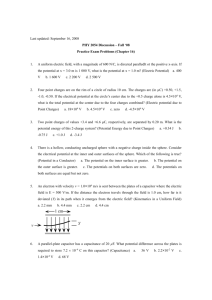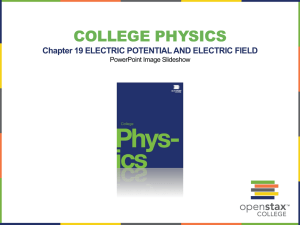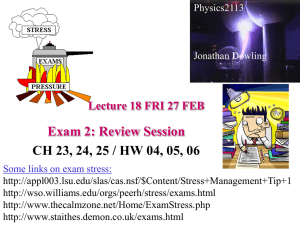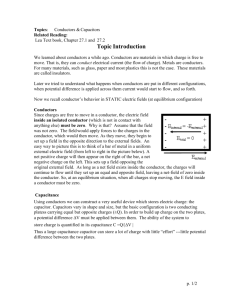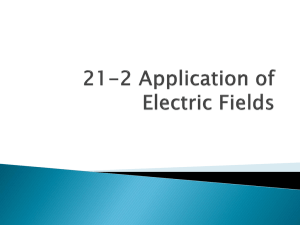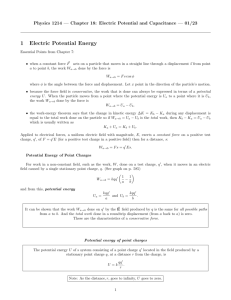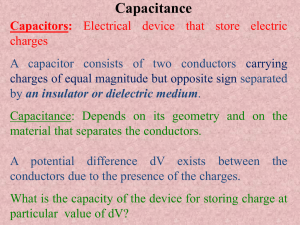Chapter 17 - HeffernanPhysics
advertisement
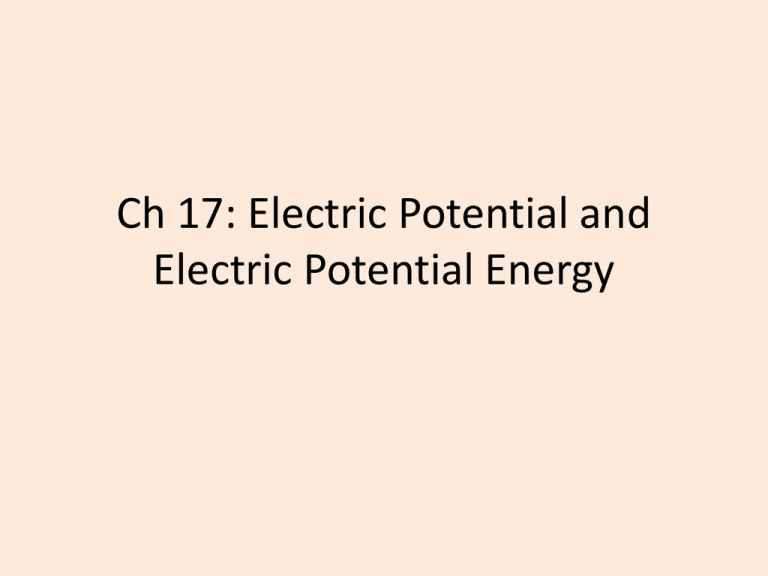
Ch 17: Electric Potential and
Electric Potential Energy
Electric Potential Energy: Parallel
Plates
• Gravitational PE is
similar to Electric PE
• Height*Gravity is similar
to Electric Potential
Electric Potential: Parallel Plates
• The electric field
between two charged
parallel plates is
uniform.
• Work has to be done on
a charge to move it.
Electric Potential: Parallel Plates
Electric Potential
• Electric potential, like electric field, is a
property of the source charges.
• Electric potential is the ability of charges to
have an interaction if other charges show up.
Electric Potential Difference
• The potential energy of a particle is
determined by knowing the charge…and the
electrical potential.
• We only care about potential difference.
• Charged particles change energy (speed up or
slow down) when they move through a
potential difference.
• Unit is Volts.
Sample Problem
• Two parallel plates, connected to a 200V
power supply, are separated by an air gap.
How small can the gap be if the air is not to
become conducting by exceeding its
breakdown value of E = 3 x 106 V/m?
Conservation of Energy
• Electric potential links electricity to
conservation of energy.
• A (+) potential difference will slow down a
positive charge.
– Will do the opposite for a (–) charge.
• A (–) potential difference will speed up a
positive charge.
– Will do the opposite for a (–) charge.
• WE ALREADY KNOW HOW TO DO THIS.
Sample Problem
• A proton with a speed of 2.0 x 105 m/s enters
a region of space in which there is an electric
potential. What is the proton’s speed after it
moves through a potential difference of
+100V?
Sample Problem
• An electron with a speed of 2.0 x 105 m/s
enters a region of space in which there is an
electric potential. What is the electron’s
speed after it moves through a potential
difference of +100V?
Electron Volt
• If an electron "falls" through a potential
difference of it gains a kinetic energy equal to
electron volt).
• Because elementary particles such as
electrons and protons are pretty small, the SI
unit of the Joule is generally too large to easily
deal with these particles.
• The electron volt is a UNIT OF ENERGY.
Conceptests
Equipotential Surfaces
• Places where electric potential is equal.
Equipotential Surfaces
• These contour lines are
analogous to
equipotential lines.
• If you move between
contour lines, you will
be changing your
gravitational potential.
• The closer together the
lines are, the steeper
the slope you are
climbing up.
Electric Potential: Point Charges
• The electric field is not uniform near a point
charge.
Electric Potential: Point Charges
• Electric potential is a SCALAR!
• That means in order to find the total potential
at a given point….add ‘em up!
• Forces and Field = vectors
• Potential and PE = scalars
Conceptests
Sample Problem
• Three point charges are arranged in the
following manner.
– What is the potential at the fourth corner taking
V=0 at a great distance?
– How much work must be done to move an
electron from infinity to point A?
Things Due
• Electric Forces (Friday @ start of class)
– Ch 16: 1, 6, 7, 12, 23, 27, 28
– *Think everyone is almost done with this.*
• Electric Fields (Friday @ start of class)
– Ch 16: 13, 14, 17, 34, 37, 67
• Electric Potential and (Friday @ start of class)
– Ch 17: 11, 15, 16, 21, 24
• AP: 1993 B2, 1996 B6, 1999 B2
• Tuesday: Quiz (Chapter 16 and 17)
– Equations and problems
– I am free every day this week 7:40-3:15
– I am afterschool Friday and Monday
ConcepTests 14-27
Capacitors
• A capacitor is a device which
can store electric charge via
two conducting objects placed
very near each other, but not
touching.
• Examples of capacitors:
– Camera flash
– Key on a keyboard
Charging a Capacitor
• While going through a battery, work is
done on charges to increase their
potential.
• The plates are initially neutral and of
area E. A battery removes charge Q;
from one plate and place it on the
other. One plate has a positive charge,
the other has a negative charge.
• Once our capacitor is fully charged
each terminal of our battery is at the
same electrical potential (voltage) as
our respectively charged plates on our
capacitor.
Simulations
• Camera flash and
keyboard key
Capacitors
• Capacitance: how “good” something is at storing
charge.
– Measured in Farads (usually picofarad-millifarad)
– The capacitance of a capacitor is only based on the
geometry.
• Capacitors store energy in the separation of
charge.
Sample Problem
• Two circular plates of radius r are separated by
an air gap of width d. What is the magnitude
of the charge on each plate when connected
to a battery of magnitude V ?
Sample Problem
• Calculate the capacitance of a parallel-plate
capacitor whose plates are 20 cm x 3.0 cm and
are separated by a 1.0 mm air gap.
– What is the charge on each plate if a 12V battery
is connected across the two plates.
– What is the electric field between the plates?
• Estimate the area of the plates needed to
achieve a capacitance of 1F, given the same air
gap.
Dielectrics
• A dielectric is made of an
insulating material.
• When placed in a
capacitor….the
capacitance goes up
because of the
rearranging of charge in
the insulator.
Capacitors
• Capacitors are useful because they store
energy by the separation of + and - charge.
Sample Problem
• A camera flash unit stores energy in a 150
microfarad capacitor at 200 V. How much
electrical energy can be stored?
Why do we Physics?
• To save lives.
• Defibrillators work
using the charging and
discharging of
capacitors.
Why do we Physics?
• To watch TV (when we were younger)
• Cathode Ray Tubes (CRT). The electrons are
"aimed" by placing a certain potential
difference on each of the deflection plates.
Why do we Physics?
• A standard issue TV works by
making the electron beam
sweep across 525 lines filling
the entire screen in 1/30 sec
• In an HDTV, the electrons
move rapidly through a greater
number of lines to create a
better looking picture.
Why do we Physics?
• Again…to save lives.
• Electrocardiogram (EKG) records potential
changes of a person’s heart.
Concept Recap
• Electric potential is the ability for there to be
potential energy.
– Potential and Potential Energy are scalars (add or
subtract them)
• Capacitors store energy by separating charge.
Practice
• Electric Potential and Capacitors (Tuesday @ start of
class)
– Ch 17: 11, 15, 16, 21, 24, 37, 39 {can skip one}
– I’d suggest about 2 hours
– Graded
• AP: 1993 B2, 1996 B6, 1999 B2, 2010 B3 (Tuesday @
start of class)
– I’d suggest about 1 hour
– To study for quiz
• Read Chapter 16 + 17 to see if there’s anything you
missed.
– I’d suggest about 1 hour


